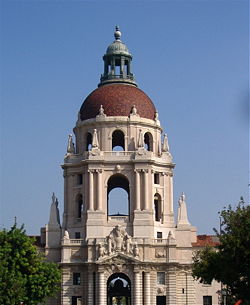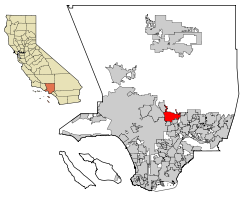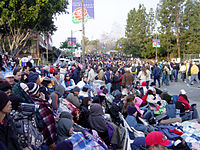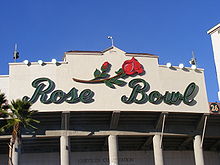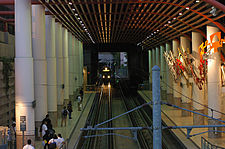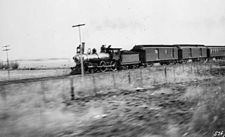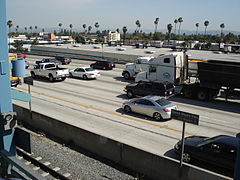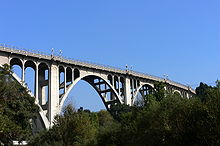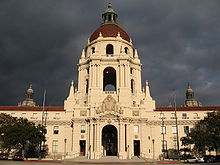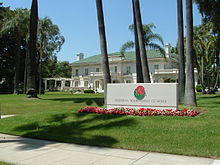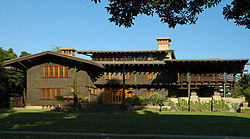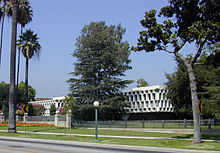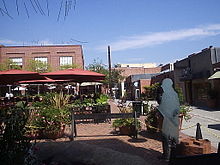- Pasadena, California
-
City of Pasadena — City — Pasadena City Hall 
SealNickname(s): City of Roses, Crown City Location in Los Angeles County and the State of California Coordinates: 34°09′22″N 118°7′55″W / 34.15611°N 118.13194°W Country United States State California County Los Angeles Settled January 27, 1874 Incorporated June 19, 1886 Government – Type Council-Manager – Mayor Bill Bogaard (D) – City Council Jacque Robinson
Margaret McAustin
Chris Holden
Gene Masuda
Victor M. Gordo
Steve Madison
Terry Tornek– City Manager Michael Beck – City Attorney Michele Beal Bagneris – City Clerk Mark Jomsky Area[1] – Total 23.128 sq mi (59.902 km2) – Land 22.970 sq mi (59.493 km2) – Water 0.158 sq mi (0.409 km2) 0.68% Elevation 863 ft (263 m) Population (2010) – Total 137,122 – Rank 9th in Los Angeles County
40th in California
180th in the United States– Density 5,928.8/sq mi (2,289.1/km2) – Demonym Pasadenan Time zone PST (UTC-8) – Summer (DST) PDT (UTC-7) ZIP codes 91101-91191 Area code(s) 626, 323 FIPS code 06-56000 GNIS feature ID 1664804 Website City website Pasadena (
 /ˌpæsəˈdiːnə/) is a city in Los Angeles County, California, United States. Although famous for hosting the annual Rose Bowl football game and Tournament of Roses Parade, Pasadena is the home to many scientific and cultural institutions, including the California Institute of Technology (Caltech), the Jet Propulsion Laboratory, Pasadena City College (PCC), Fuller Theological Seminary, Art Center College of Design, the Pasadena Playhouse, Le Cordon Bleu School of Culinary Arts-Pasadena, the Norton Simon Museum of Art and the Pacific Asia Museum.
/ˌpæsəˈdiːnə/) is a city in Los Angeles County, California, United States. Although famous for hosting the annual Rose Bowl football game and Tournament of Roses Parade, Pasadena is the home to many scientific and cultural institutions, including the California Institute of Technology (Caltech), the Jet Propulsion Laboratory, Pasadena City College (PCC), Fuller Theological Seminary, Art Center College of Design, the Pasadena Playhouse, Le Cordon Bleu School of Culinary Arts-Pasadena, the Norton Simon Museum of Art and the Pacific Asia Museum.As of 2010 United States Census, the population of Pasadena was 137,122, making it the 180th-largest city in the United States, down from 168th place in 2009.[2] Pasadena is the ninth-largest city in Los Angeles County, and on June 19, 1886, became the fourth to be incorporated in Los Angeles County, after Anaheim (March 18, 1876) and Santa Ana (June 1, 1886), which were part of Los Angeles County until Orange County was formed in 1889. It was largely as a ploy to get rid of its saloons.[3][4] It is one of the primary cultural centers of the San Gabriel Valley.[5]
History
Main article: History of Pasadena, CaliforniaDemography
2010
The 2010 United States Census[6] reported that Pasadena had a population of 137,122. The population density was 5,928.8 people per square mile (2,289.1/km²). The racial makeup of Pasadena was 76,550 (55.8%) European American, 14,650 (10.7%) African American, 827 (0.6%) Native American, 19,595 (14.3%) Asian, 134 (0.1%) Pacific Islander, 18,675 (13.6%) from other races, and 6,691 (4.9%) from two or more races. Hispanic or Latino of any race were 46,174 persons (33.7%).
The Census reported that 133,629 people (97.5% of the population) lived in households, 2,472 (1.8%) lived in non-institutionalized group quarters, and 1,021 (0.7%) were institutionalized.
There were 55,270 households, out of which 14,459 (26.2%) had children under the age of 18 living in them, 22,285 (40.3%) were opposite-sex married couples living together, 6,131 (11.1%) had a female householder with no husband present, 2,460 (4.5%) had a male householder with no wife present. There were 3,016 (5.5%) unmarried opposite-sex partnerships, and 704 (1.3%) same-sex married couples or partnerships. 18,838 households (34.1%) were made up of individuals and 5,748 (10.4%) had someone living alone who was 65 years of age or older. The average household size was 2.42. There were 30,876 families (55.9% of all households); the average family size was 3.18.
The population was spread out with 26,507 people (19.3%) under the age of 18, 12,609 people (9.2%) aged 18 to 24, 45,371 people (33.1%) aged 25 to 44, 34,073 people (24.8%) aged 45 to 64, and 18,562 people (13.5%) who were 65 years of age or older. The median age was 37.2 years. For every 100 females there were 95.1 males. For every 100 females age 18 and over, there were 93.5 males.
There were 59,551 housing units at an average density of 2,574.8 per square mile (994.1/km²), of which 24,863 (45.0%) were owner-occupied, and 30,407 (55.0%) were occupied by renters. The homeowner vacancy rate was 2.3%; the rental vacancy rate was 6.6%. 64,306 people (46.9% of the population) lived in owner-occupied housing units and 69,323 people (50.6%) lived in rental housing units.
About 11.6% of families and 15.9% of the population were below the poverty line, including 21.3% of those under age 18 and 10.5% of those age 65 or over.[5]
Geography
Pasadena is located at 34°9′22″N 118°7′55″W / 34.15611°N 118.13194°W (34.156098, -118.131808).[7] The elevation at City Hall is 864 feet (263 m) above sea level. The greater Pasadena area is bounded by the Raymond Fault line, the San Rafael Hills, and the San Gabriel Mountains. The Arroyo Seco, a major geographic feature and home of the Rose Bowl, flows from headwaters in Pasadena's towering Angeles National Forest greenbelt in the San Gabriel Mountains.[5]
According to the United States Census Bureau, the city has a total area of 23.1 square miles (60 km2), over 99% of it land; 0.68% is water.[1]
Ten miles (16 kilometers) northeast of downtown Los Angeles, Pasadena is bordered by 11 communities: Highland Park, Eagle Rock, South Pasadena, San Marino, Temple City, San Gabriel, Arcadia, Sierra Madre, La Cañada Flintridge, and Altadena. The communities of Eagle Rock, Highland Park and Garvanza are incorporated within the city of Los Angeles and Altadena is an unincorporated part of Los Angeles County.[5]
Tournament of Roses Parade
Pasadena is home to the Tournament of Roses Parade, held each year on January 1 (or on January 2, if the 1st falls on a Sunday). The first parade was held in 1890 and was originally sponsored by the Valley Hunt Club, a Pasadena social club. The motivation for having the parade was, as member Professor Charles F. Holder said, "In New York, people are buried in snow. Here our flowers are blooming and our oranges are about to bear. Let's hold a festival to tell the world about our paradise."[8]
By 1895, the festivities had outgrown the Valley Hunt Club, and the Tournament of Roses Association was formed to take charge of the parade. The Rose Parade, as it is familiarly known, traditionally features elaborate floats. According to the organizers, "Every inch of every float must be covered with flowers, or other natural materials, such as leaves, seeds, or bark. On average a float requires about 100,000 flowers and greenery. Volunteer workers swarm over the floats in the days after Christmas, their hands and clothes covered with glue and petals."[9] The most perishable flowers are placed in small vials of water, which are placed onto the float individually. Over the almost 3 hours of the parade, floats, and participants travel over five miles (8 km)[9] and pass by over one million viewers who traditionally camp out over New Year's Eve to have the best view along the parade route.[10]
The Rose Parade is satirized by the popular Doo Dah Parade, an annual event that originated in Old Pasadena in 1978, and soon gained national notoriety.[11] Readers Digest named the Doo Dah Parade “America’s Best Parade”, and was a recent feature in 50 Places You Must Visit Before You Die!.[11] It was formerly held around Thanksgiving, a month before the Rose Parade,[12] but the parade is now held in May. In 2011, after 33 years in Pasadena, the parade moved to East Pasadena for the first time.[10] It features unusual and absurd entrants such as the BBQ & Hibachi Marching Grill Team, the Men of Leisure, and the Bastard Sons of Lee Marvin.[11] Proceeds from the parade's pancake breakfast, t-shirts, and after-party are donated to charity.[11][13]
Rose Bowl Game
The Rose Bowl, a National Historic Landmark, is host of the first, oldest, and most famous college football postseason bowl game, the Tournament of Roses Rose Bowl Game, every New Year's Day. In 1895, the Tournament of Roses Association was formed to take charge of the parade. In 1902, the association declared that a football game would be added to the day's events. The game, now known as the Rose Bowl, would become the first New year's post-season college football game ever and has developed into a tradition in many college arenas. Soon outgrowing its original facility, a new stadium was constructed in the Arroyo Seco area. The new stadium hosted its first New Year's Day football game in 1923 and was soon christened "The Rose Bowl."[8]
Facilities
Rose Bowl Stadium
In addition to the annual New Year's Day Rose Bowl game and the BCS National Championship game every four year, the stadium is the home field for the UCLA Bruins football team and has hosted five Super Bowls. Important soccer matches include the 1984 Summer Olympics,[14] the final game of the 1994 FIFA World Cup,[15] and the final game of the 1999 FIFA Women's World Cup.[16]
The Rose Bowl stadium was the home ground for the Los Angeles Galaxy of Major League Soccer from the team's inception in 1996 until in 2003, it moved into the soccer-specific Home Depot Center in Carson, California. The venue additionally hosted the 1998 MLS Cup.[17] Many concerts and other events have been held in the stadium, such as a U2 concert in 2009.[18]
Aquatic and tennis centers
The Rose Bowl Aquatics Center is an aquatics facility located adjacent to the Rose Bowl Stadium. The pool hosted the final practices of the 2000 US Olympic swimming and diving team. In 2008, the facility held the U.S. National Diving Championships.[19] The Rose Bowl Tennis Center, operated by the city of Pasadena, is located due south of the Rose Bowl stadium.[20]
Government
Federal, state, and county government
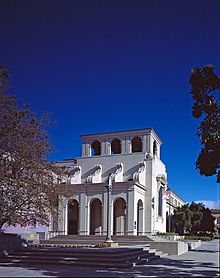 Architect Robert A. M. Stern chose a bold design for the new Pasadena, California Police Department Building, which opened in 1990.
Architect Robert A. M. Stern chose a bold design for the new Pasadena, California Police Department Building, which opened in 1990.
Federally, Pasadena is located in California's 29th congressional district, which has a Cook PVI of D +12[21] and is represented by Democrat Adam Schiff. Although Pasadena has been liberal in state politics, in national politics, it was a stronghold for moderate Republicans; it was represented in Congress by Republicans from 1945 to 2001.[citation needed] In the state legislature Pasadena is located in the 21st Senate District, represented by Democrat Jack Scott, and in the 44th Assembly District, represented by Democrat Anthony J. Portantino. The Los Angeles County Department of Health Services operates the Monrovia Health Center in Monrovia, serving portions of Pasadena.[22]
Local government
According to the city's most recent Comprehensive Annual Financial Report of 2009, the city's various funds had $583.0 million in revenues, $518.1 million in expenditures, $954,199,439 in net assets, $732.3 million in total liabilities, and $118,261,490 in cash and investments.[23][24]
Police services
The Pasadena Police Department serves most of the City of Pasadena. Unincorporated portions of the city are part of Los Angeles County and are served by the Los Angeles County Sheriff's Department (LASD) and the Altadena Station in Altadena serves nearby portions of Pasadena.[25]
Fire Department
The Pasadena Fire Department moved into its first formal and permanent station in 1889. Before that they had been housed in a ramshackle structure and summoned by the church bell. There were 24 firemen for two shifts.[26] Today The Pasadena Fire Department consists of 185 full time employees, 153 shift personnel, 32 administrative personnel, and eight modern fire stations that serve an area in a radius of 60 miles (97 km).[27]
Water and Power Department
Pasadena Water and Power Department (PWP) provides services to an area 60 km2 (23 sq mi) and includes areas outside of the city proper including unincorporated areas of southern Altadena, East Pasadena, Chapman Woods, and East San Gabriel.
Pasadena created the Pasadena Municipal Light and Power Department in 1906. On May 3, 1906,a $125,000 bond was issued to pay for the construction of a power plant. This first power plant was a wood frame and corrugated sheet iron structure which housed one 200-kW Crocker-Wheeler generator driven by a Fleming-Corliss engine, one 200-pound pressure boiler, a condenser, pumps, and other auxiliary equipment and only supplied power to the city's street lights. Expanding continued and more generating capacity was expanded and the city then offered power to commercial customers in 1908, and bought out Southern California Edison's Pasadena operations in 1920.[28] In 1928 the City contracted with federal government to buy electricity from Boulder Dam, later renamed Hoover Dam, which began delivering power in 1935.
During the Depression the power company extended its building programs to provide short term jobs for citizens by severally affected by the collapse of the economy. Customers were permitted to work for the company for two week periods to earn money for food, utility bills and housing. Following many further improvements, two 50,000 KW generating units in a completely new outdoor plant went on-line in 1955 and 1958. in June 1965, a 71 MW, 83 MVA reheat unit with steam backup auxiliaries was put into service to cover the growing needs for more power in the City.
In 1911 the city began condemnation actions against a number of small, local water companies. In 1912 the Water Department was created and in 1913 it began actual operations. The City continued to acquire small, local water companies for several decades afterwards, usually en toto, such as the Pasadena Lake Vineyard and Land Company, and sometimes in part, such as Las Flores Water Company's southern portions and San Gabriel Valley Water Company's operations in the southern reaches of Pasadena. In 1915 the Water Department added a chlorine generation system (from the Electro Beaching Gas Company of New York)to disinfect water taken from the Arroyo Seco. In the late 1920s Pasadena took the initiative to obtain water from the Colorado River and lead the formation of the Metropolitan Water District of Southern California (MWDSC or "Met").[29] The charter for the MWDSC was signed on November 6, 1928. In 1967 the Water Department and the Light and Power department were consolidated into the "Pasadena Water and Power Department" (or PWP).[28]
It operates a number of wells, has a spreading ground for the capture of surface water from the Arroyo Seco, and purchases surface water from MWDSC. Historically water from the Arroyo Seco and Eaton Canyon were collected and distributed directly to the service areas. Not long after the City took over operations, 1915, chlorine was added to the Arroyo Seco water. In 1971 the John Behner Treatment Plant was constructed to give full surface water treatment to the Arroyo Seco water. Eventually as regulatory limits were made more strict, PWP ceased all direct surface water treatment. The use of spreading grounds to recharge ground water on both the Arroyo Seco and Eaton Canyon capture considerable volumes of water, a little over 2,000 acre feet (2,500,000 m3) per year.
A number of wells on the west side of the service area had become contaminated with volatile organic chemicals and perchlorate and had to be shut down several years. A treatment plant was built to remove these chemicals which began operation in July 2011.
Transportation
Public transit
Pasadena is the northern terminus of the Los Angeles Metro Gold Line light rail, which originates at the Atlantic Station in East Los Angeles. Opening in 2003,[30] there are currently 6 Gold Line stations in Pasadena: Fillmore Station, Del Mar Station in Old Pasadena, Memorial Park Station in Old Pasadena, Lake Station in Downtown, Allen Station and Sierra Madre Villa Station. Construction began in June 2010 to extend the Gold Line east through several additional foothill communities of the San Gabriel Valley.
Pasadena is also served by various bus services. The Pasadena Area Rapid Transit System exclusively serves the city while Los Angeles metro area bus services Foothill Transit, LADOT, Metro Local and Metro Rapid also serve Pasadena.[31]
Trains
Pasadena was served by the Atchison, Topeka and Santa Fe Railway at a Santa Fe Depot in downtown when the Second District was opened in 1887.[32] In 1925, the historical and traditionally-styled station in Pasadena was opened.[32] Originally, the Second District was an invaluable line; it served manufacturing and agricultural businesses throughout the entire San Gabriel Valley. Unfortunately, the longer trains had great difficulty climbing the precipitous 2.2% grade at Arroyo Seco, between Pasadena and Los Angeles. Additional locomotives were often necessary, causing a more costly and less efficient operation. The still-used Third District opened in 1888, just a year after the Second District, and rapidly took over most of longer freight trains more efficaciously.[32]
The Second District and the Pasadena Depot became well known by the many transcontinental passenger trains that it served. Historically, up to 26 passenger trains went through Pasadena every day. In order to avoid the media in Los Angeles, many celebrities chose to use Pasadena as their main train station, bringing to it an ambience and legacy of the glamour of old Hollywood.[32][33]
Amtrak took over passenger rail operations in 1971, serving Pasadena with trains such as the Southwest Chief, Las Vegas Limited, and Desert Wind. On January 15, 1994, the final Southwest Chief train arrived in Pasadena.[33] ATSF sold the line between Los Angeles and San Bernardino via Pasadena (known as the "second division"). (Now the Southwest Chief operates over the transcon via Fullerton.) The LACMTA Gold Line still uses the same right-of-way (although different tracks) as the Santa Fe did. The old depot is still visible at the Del Mar station.
Airports
Bob Hope Airport (also known as Burbank-Glendale-Pasadena Airport) in nearby Burbank serves as the regional airport for Pasadena. The airport is owned and operated by the Burbank-Glendale-Pasadena Airport Authority. The airport is under the control of the governments of the three cities for which it is named. Most destinations from Bob Hope Airport are within the United States, so Los Angeles International Airport in Los Angeles and LA/Ontario International Airport in Ontario are also important airports less than an hour from Pasadena. Long Beach Airport in Long Beach, California, is about an hour's drive away. John Wayne Airport in Orange County, California is slightly more than an hours drive away from Pasadena.
Freeways and highways
Four freeways run through Pasadena, and Pasadena is a control city for all of them. The most important is the Foothill Freeway (I-210) which enters the northwestern portion of the city from La Cañada Flintridge. The Foothill Freeway initially runs due south, passing the Rose Bowl before its junction with the Ventura Freeway. At this interchange, the Foothill Freeway shifts its alignment and direction, becoming an east-west freeway, exiting the city on its eastern boundary before entering Arcadia. The Foothill Freeway connects Pasadena with San Fernando (westbound) and San Bernardino (eastbound).
The Ventura Freeway (SR 134) starts at the junction of the Foothill Freeway (I-210) at the edge of downtown Pasadena and travels westward. This freeway is the main connector to Bob Hope Airport and the San Fernando Valley.
A spur of the controversial Long Beach Freeway (SR 710 in Pasadena) is also located in Pasadena. The Long Beach Freeway was intended to connect Long Beach to Pasadena but a gap, known as the South Pasadena Gap, between Alhambra and Pasadena has not been completed due to legal battles involving the city of South Pasadena. The spur starts at the junction of the Ventura Freeway and Foothill Freeway and travels south along the eastern edge of Old Pasadena with two exits for Colorado Boulevard and Del Mar Boulevard before ending at an at-grade intersection with California Boulevard. Currently, Caltrans is researching the possibility of using advanced tunneling technologies to build the Long Beach Freeway under South Pasadena without disturbing the residential neighborhoods on the surface. This would create twin tunnels that are 4.5 miles (7.2 km) long, the longest in the United States.
The Arroyo Seco Parkway (SR 110) (also known as the Pasadena Freeway) is the first freeway in California, connecting Los Angeles with Pasadena alongside the Arroyo Seco and is the primary access to Downtown Los Angeles. The freeway enters the southern part of the city from South Pasadena. Only one exit is actually inside city limits, the southbound exit connecting to State Street with access to Fair Oaks Avenue. At Glenarm Street, the freeway ends and the four-lane Arroyo Parkway continues northward to Old Pasadena.
Three state highways enter the city of Pasadena. Arroyo Parkway (SR 110), maintained by the city of Pasadena, runs from the termination of the Pasadena Freeway at Glenarm Street to Colorado Boulevard in Old Town Pasadena. While Arroyo Parkway continues north two more blocks, SR 110 ends at Glenarm Street.
Rosemead Boulevard (SR 19) is a state highway on the eastern edge of Pasadena and unincorporated Pasadena from Huntington Drive to Foothill Boulevard.
An obscure portion of the Angeles Crest Highway (SR 2) in the San Gabriel Mountains cuts through Pasadena near the Angeles Crest Ranger Station. This 2-mile (3.2 km) stretch of highway in the Angeles National Forest is north of La Cañada Flintridge and west of Mount Wilson and is approximately 3,000 feet (910 m) in elevation.
Historic U.S. Route 66 used to run through Pasadena until it was decommissioned in 1964. The historic highway entered Pasadena from the east on Colorado Boulevard and then jogged south on Arroyo Parkway before becoming part of the Pasadena Freeway (SR 110).
The intersection of Fair Oaks Avenue and Colorado Boulevard in Old Pasadena is the zero-zero, east-west, north-south postal division of Pasadena.
Culture
Performing arts
The Pasadena Symphony, founded in 1862, offers several concerts a year at the Pasadena Civic Center and the Pasadena Pops plays at the Rose Bowl. The Civic Center also holds a few traveling Broadway shows each year. The legendary Pasadena Playhouse, presently in reorganization, usually presents seven shows a season, each show running six to eight weeks. The Furious Theatre Company is one of several small theatre companies in Pasadena. They are currently housed in the Carrie Hamilton Theatre adjacent to the Pasadena Playhouse. Boston Court Performing Arts Center, opened in 2003, is near Lake and Colorado. Its resident theatre company, the award-winning The Theatre @ Boston Court presents four productions a year.[34] Music at the Court presents numerous music concerts each year, ranging from classical to jazz. The Friends of the Levitt organization presents a free summer concert series in Memorial Park, with the 2008 summer season marking its sixth year.
Beckman Auditorium and other venues on the Caltech campus present a wide range of performing arts, lectures, films, classes and entertainment events, primarily during the academic year.[35]
The California Philharmonic performs two series in Pasadena, Cal Phil at the Ambassador Auditorium from November through April, and Cal Phil Music Martinis & the Maestro in the Romanesque Room at the Green Hotel from January to May. They also perform Cal Phil Festival on the Green at nearby Los Angeles County Arboretum & Botanic Garden in Arcadia from July to September, and from July to August Cal Phil at Walt Disney Concert Hall in Los Angeles. In conjunction with The Old Mill Foundation, they perform a summer chamber concert series Cal Phil at the Mill in San Marino.
For more than ten years, twice annually Pasadena's cultural institutions have opened their doors for free during ArtNight Pasadena,[36] offering the public a rich sampling of quality art, artifacts and music within the city. This has evolved into the yearly PasadenART Weekend,[37] a three day citywide event which, as of 2007, encompasses ArtNight, ArtWalk, ArtHeritage, ArtMarket, and ArtPerformance, a vibrant outdoor music event showcasing emerging and nationally recognized talent. Free concerts take place on multiple stages throughout Old Pasadena.[38]
Ambassador Auditorium was built under the guidance of Herbert W. Armstrong as both a facility to be used by the Worldwide Church of God for religious services and as a concert hall for public performances celebrating the performing arts. In 2007, the native Pasadena band Ozma reunited and produced the album Pasadena in tribute to the city. The album photos and artwork were shot at the Colorado Street Bridge.[citation needed]
The 1960s song "The Little Old Lady from Pasadena" parodies a popular Southern California image of Pasadena as home to a large population of aged eccentrics. In the song, Jan and Dean sing of an elderly lady who drives a powerful "Super Stock Dodge" muscle car and is "the terror of Colorado Boulevard." The Dead Kennedys paid a tribute to this archetypal song in the track "Buzzbomb From Pasadena" in the album Give Me Convenience or Give Me Death.
Visual arts
A number of artists of national repute, such as Guy Rose, Alson S. Clark, Marion Wachtel and Ernest A. Batchelder, of the Arts and Crafts Movement, made Pasadena their home in the early twentieth century. The formation of the California Art Club, Pasadena Arts Institute and the Pasadena Society of Artists heralded the city's emergence as a regional center for the visual arts.
Museums and galleries
Pasadena is home to a number of art museums and public galleries, including the Norton Simon Museum, widely acknowledged as one of the finest art collections in the Western United States.[citation needed] The museum's collections include European paintings, sculpture, and tapestry; sculpture from Southern Asia; and an extensive sculpture garden. The museum also has the contemporary art collection of its predecessor, the Pasadena Museum of Art, which focused on modern and contemporary art before being taken over by Simon in the early 1970s.[39]
Preserving and sharing the rich history and culture of Pasadena and its adjacent communities is the Pasadena Museum of History. Located on a campus of 2 acres (8,100 m2), it has gardens, a history center, the Finnish Folk Art Museum, the Curtin House, and the Fenyes Mansion, a 1906 Beaux Arts-style architectural residence and a Pasadena Cultural Heritage Landmark.[citation needed]
The Pacific Asia Museum, with a garden courtyard in its center, features art from the many countries and cultures of Asia. The nearby Pasadena Museum of California Art hosts changing exhibitions of work by historical and contemporary California artists.[40] The Armory Center for the Arts has an extensive exhibition program as well as serving as a center for art education for all ages.[41] Art Center College of Design offers exhibitions at its Williamson Gallery, as well as frequent displays of student work.[42] Pasadena City College has an art gallery that shows work of professionals as part of their annual artist-in-residence program, as well as exhibiting work by students and faculty.[43]
The Huntington Library and Botanical Gardens, with painting and sculpture galleries, is adjacent to Pasadena in the city of San Marino.[44] The innovative Kidspace Children's Museum is located in Brookside Park.[45]
Literature
In 2002 David Ebershoff published the novel Pasadena. The novel won praise for its accurate recreation of Pasadena before World War II.[46]
Bungalow Heaven
Main article: Bungalow HeavenBungalow Heaven is a neighborhood of 800 small craftsman homes built from 1900 to 1930. Many of these homes are still occupied. Much of the area became a landmark district in 1989,[47] and annual historic home tours have been conducted since that designation.[48][49] Bungalow Heaven's borders are Washington Boulevard to the north, Orange Grove Boulevard to the south, Mentor Avenue to the west, and Chester Avenue to the east.[50] The neighborhood is usually extended to Lake Avenue to the west and Hill Avenue to the east.[47][51]
Orange Grove Boulevard
Main article: Orange Grove BoulevardThe Norton Simon Museum is at the intersection of Orange Grove and Colorado Boulevards. This corner is the official start of the Rose Parade route and the museum can be quite clearly seen every year during the parade television broadcast.
Orange Grove Boulevard is one of several exclusive residential districts in Pasadena, and has been a home for the rich and famous since the early 20th century. Because of the number of landmark mansions, the street earned the name Millionaire's Row, an appropriate sobriquet considering that the estates that once lined this spacious boulevard and the surrounding neighborhood read like a Who's Who of American consumer products.
Historical estates
The maker of Wrigley's chewing gum, William Wrigley Jr.'s, substantial home was offered to the city of Pasadena after Mrs. Wrigley's death in 1958, under the condition that their home would be the Rose Parade's permanent headquarters.[52] The stately Tournament House stands today, and serves as the headquarters for the Tournament of Roses Parade.[53][54] Adolphus Busch, co-founder of Anheuser-Busch, brewer of Budweiser beer, established the first of a series of Busch Gardens in Pasadena. When Busch died at his Pasadena estate, his wife generously offered the property to the City of Pasadena, an offer the city inexplicably refused. Henry Markham, who lived adjacent to Busch, was the 18th Governor of the state of California (1891–1895) and wrote Pasadena: Its Early Years.[55] The home of David Gamble, son of consumer product maker James Gamble of Procter & Gamble, is located on the north end of Orange Grove Boulevard.
The Gamble House, an American Craftsman masterpiece, was built in 1908,[56] by architects Charles and Henry Greene, as an exemplification of their ultimate bungalow. It is open to the public as both an architectural conservancy and museum.[57]
The Gamble House is a California Historical Landmark and a National Historic Landmark on the National Register of Historic Places. In 1966, it was deeded to the city of Pasadena in a mutual agreement with the University of Southern California School of Architecture. Every year, two fifth-year USC architecture students live in the house full-time. The students change yearly.[61]
The home of Anna Bissell McCay, daughter of carpet sweeper magnate Melville Bissell is a four-story Victorian home, on the border of South Pasadena. Today the Bissell House is a bed and breakfast.[62] Thaddeus S. C. Lowe's home of 24,000 square feet (2,200 m2) was on South Orange Grove. The house included a sixth story solarium which he converted into an observatory. Lowe was also a generous patron of the astronomical sciences. He started a water-gas company, founded the Citizens Bank of Los Angeles, built numerous ice plants, and purchased a Pasadena opera house. He also established the Mount Lowe Railway in the mountains above Pasadena and eventually lost his fortune.[63] The brilliant, but troubled, rocket scientist John Whiteside Parsons sometimes shared his residence with other noteworthy people, including L. Ron Hubbard, the founder of Scientology. Parsons died in an explosion while testing a new rocket fuel in his Pasadena home laboratory, in 1952.[64]
Education
The California Institute of Technology is in the southern-central area of Pasadena. The Jet Propulsion Laboratory (managed for NASA by Caltech) is in Pasadena.[65] Caltech's 31 Nobel Laureates have brought 32 Nobel Prizes home to Pasadena.[66] In 2005, Caltech dedicated an on-campus weather station honoring the late Nobel laureate geneticist and meteorologist Ed Lewis. The Ed Lewis Memorial Weather Station generates weather information for KNBC and thousands of other Web sites on school campuses in Pasadena and all over the nation.[67] Fuller Theological Seminary, one of the largest multidenominational seminaries in the world,[68] sits just east of downtown Pasadena. The Le Cordon Bleu College of Culinary Arts (formerly known as the California School of Culinary Arts) is located at East Green Street and South Madison Avenue. The school offers the Le Cordon Bleu accreditation and has two campuses in Pasadena. Pacific Oaks College is located next to Pasadena's National Historic Landmark, the Gamble House. The Art Center College of Design is in the San Rafael Hills overlooking the Rose Bowl, and ranks as one of the top five art schools in the United States and one of the top 10 art schools worldwide;[69] it is particularly known for its design programs.
Los Angeles Music Academy College of Music, founded in 1996, is a contemporary music school whose acclaimed faculty of experienced professionals are active in the film, television and recording industries. The school is located between Colorado and California Boulevards on South Fair Oaks Boulevard.
Pasadena City College is a highly rated community college founded in 1924 and located on Colorado Boulevard, slightly northeast of Caltech. Until about 1970, the Rose Parade Queen's court was exclusively selected from its students. PCC alumni include Jackie Robinson and Jaime Escalante.[70]
The Pasadena Unified School District encompasses 76 square miles (200 km2) and includes Pasadena, Altadena and Sierra Madre. There are 17 K-5 elementary schools, five middle schools, and four high schools.[71] There are also a number of private and parochial schools in the city.
Pasadena had a public library before it was incorporated as a city.[citation needed] The Pasadena Central Library was designed by architect Myron Hunt and dedicated in 1927.[72] The library has an area of 110,000 square feet (10,000 m2) and was recently renovated without damaging any of its historic integrity.[72] It has been the scene of scholars in movies too numerous to mention.[citation needed] It is listed on the National Register of Historic Places.[72]
Economy
According to the City's 2011 Comprehensive Annual Financial Report,[73] the top employers in the city are:
# Employer # of Employees 1 Jet Propulsion Laboratory 5,038 2 Kaiser Permanente 4,500 3 California Institute of Technology 3,628 4 Huntington Hospital 3,260 5 Pasadena City College 2,719 6 Pasadena Unified School District 2,665 7 AT&T 2,565 8 City of Pasadena 2,239 9 Bank of America 1,500 10 Art Center College of Design 877 11 Parsons 786 12 Hathaway-Sycamores 615 13 Pacific Clinics 550 14 San Gabriel Valley Newspaper Group 525 15 The Langham Huntington 511 16 Rusnak Auto Group 450 17 Avon Products 238 Other companies based in Pasadena include Avery Dennison, Cogent Systems, East West Bank, Inter-Con Security, Jacobs Engineering Group, OneWest Bank, Tetra Tech, Wesco Financial, and Wetzel's Pretzels.
Shopping and dining
Old Pasadena spans 21 blocks downtown. It boasts upscale retail shops and a wide variety of restaurants, nightclubs, outdoor cafés, pubs, and comedy clubs. "One Colorado" features renovated historic architecture that attracted the new retail stores and restaurants. This development filled vacant buildings and was the impetus of the revitalization of Old Town on Colorado Boulevard.[74] Paseo Colorado is an upscale shopping mall designed to be a modern urban village. An open-air mall that covers three city blocks, Paseo Colorado is anchored on the west end by upscale grocery store Gelson's, on the east end by Macy's and Arclight Cinemas centers the middle portion of the mall. Another shopping district is located in the South Lake Avenue neighborhood. On Lake Avenue, an old Macy's department store and furniture gallery is in a registered California historical landmark. The building was originally designed and built as the fourth Bullock's department store in the mid 1950s (the last freestanding store they constructed).[75]
Rose Bowl Flea Market
The Rose Bowl Flea Market is a large swap meet that involves thousands of dealers and tens of thousands of visitors in and around the grounds of the Rose Bowl. The merchandise on display ranges from old world antiques to California pottery to vintage clothing. The flea market has been held every second Sunday of the month, rain or shine, since 1967.[76]
Climate
Pasadena has a Mediterranean climate (Köppen climate classification Csa).
Climate data for Pasadena Month Jan Feb Mar Apr May Jun Jul Aug Sep Oct Nov Dec Year Record high °F (°C) 93
(34)92
(33)96
(36)105
(41)102
(39)110
(43)110
(43)107
(42)110
(43)108
(42)98
(37)93
(34)110
(43)Average high °F (°C) 65
(18)68
(20)71
(22)76
(24)78
(26)84
(29)89
(32)91
(33)88
(31)82
(28)74
(23)68
(20)78 Average low °F (°C) 39
(4)44
(7)47
(8)50
(10)54
(12)57
(14)61
(16)62
(17)61
(16)55
(13)48
(9)44
(7)52 Record low °F (°C) 23
(−5)15
(−9)23
(−5)34
(1)37
(3)41
(5)45
(7)48
(9)44
(7)37
(3)29
(−2)26
(−3)15
(−9)Precipitation inches (mm) 4.48
(113.8)5.00
(127)4.38
(111.3)1.22
(31).45
(11.4).21
(5.3).05
(1.3).21
(5.3).48
(12.2).65
(16.5)1.50
(38.1)2.40
(61)21.09
(535.7)Source: [77] The wettest year was 1983 with 48.47 inches (1,231 mm) and the driest year was 1947 with 5.37 inches (136 mm). The most rainfall in one month was 19.70 inches (500 mm) in February 1980. The most rainfall in 24 hours was 7.70 inches (196 mm) on March 2, 1938. Pasadena averages 21 inches (530 mm) of rain a year, about 6 inches more than nearby Los Angeles due to the rain shadow effect created by the San Gabriel Mountains. Situated at the base of the San Gabriel Mountains, snow is known to fall occasionally in Pasadena. The heaviest snowfall in Pasadena history occurred on January 11, 1949; 6 inches fell at Pasadena's city hall and more than 12 inches (300 mm) fell in the foothills of the city.[78]
Media
Civic Auditorium venue
The Civic Auditorium is on Green Street. It was designed to be the south cornerstone of Pasadena's Civic Plaza. Every year, the popular television competition, American Idol films their "Hollywood Week" show there.[79] It was also the venue for the Miss Teen USA 2007 pageant. The main auditorium is large enough to have been home to the annual Emmy Awards ceremony for nearly 25 years, from 1977 to 2001.[80]
Television
Pasadena is the setting of many TV shows including Brothers & Sisters[81] and The Big Bang Theory.[82] Pasadena Community Access Corporation oversees four television stations: The Arroyo Channel (Channel 32), KPAS (Channel 3), KLRN (Channel 95) and PCC TV (Channel 96).
Radio
Pasadena has been home to a number of notable radio stations. In 1967 radio iconoclasts Tom and Raechel Donahue took over an aging studio in the basement of the Pasadena Presbyterian Church and introduced Los Angeles to FM freeform radio. Broadcasting under the KPPC-FM call sign at 106.7 FM it quickly became the voice of the counterculture and provided the soundtrack to LA's hippie era.[citation needed] Early on-air personalities included Michael McKean, David Lander, Harry Shearer, and Dr. Demento. The staff was fired en masse in 1971 and the station lost its distinctive personality.[citation needed]
Today the primary radio station in Pasadena goes by the call sign KPCC located at 89.3 FM. Broadcasting from the Pasadena City College campus, this public radio station carries many shows from National Public Radio but maintains an independent streak, committing a large chunk of air time to presenting local and state news. Accordingly, the station has received numerous awards for journalistic excellence and continues to be an important part of the city's heritage.[citation needed]
Newspapers
Pasadena's largest newspaper is the Pasadena Star-News, which was first published in 1884. The alternative Pasadena Weekly is published by Southland Publishing. The Pasadena Sun, a community weekly, is published by The Los Angeles Times.
Notable residents
Parrots
Pasadena has a large, non-indigenous population of naturalized parrots. According to the "Parrot Project of Los Angeles",[83] the parrots are of at least five species.[84][85] Some residents have come to enjoy the birds as part of their unique city's culture,[86][87] while others consider them to be loud pests. Many theories surround the mystery of how the parrots landed in Pasadena and claimed the area as their own.[88] A widely accepted story is that they were part of the stock that were set free for their survival from the large pet emporium at Simpson's Garden Town on East Colorado Boulevard, which burned down in 1959.[85][89]
International relations
Twin towns / sister cities
Pasadena has seven sister cities, as designated by Sister Cities International:
 Järvenpää, Finland
Järvenpää, Finland Ludwigshafen am Rhein, Germany
Ludwigshafen am Rhein, Germany Poznań, Poland
Poznań, Poland Mishima, Japan
Mishima, Japan Vanadzor, Armenia
Vanadzor, Armenia Xicheng District, Beijing, China
Xicheng District, Beijing, China Tangier, Morocco
Tangier, Morocco
See also
Notes
A The number of people counted statistically in demographics will sometimes exceed 100% because some Hispanics and Latinos identify as both White and Hispanic.[90] See Race and ethnicity in the United States census.
References
- ^ a b U.S. Census
- ^ "Table 1: Annual Estimates of the Resident Population for Incorporated Places Over 100,000, Ranked by July 1, 2009 Population: April 1, 2000 to July 1, 2009" (CSV). 2009 Population Estimates. United States Census Bureau, Population Division. 2010-07-19. http://www.census.gov/popest/cities/tables/SUB-EST2009-01.csv. Retrieved 2010-07-19.
- ^ The City of Pasadena website, History 1886-1920 x
- ^ Los Angeles County - 1866 to 1886
- ^ a b c d City of Pasadena website, Statistics
- ^ All data are derived from the United States Census Bureau reports from the 2010 United States Census, and are accessible on-line here. The data on unmarried partnerships and same-sex married couples are from the Census report DEC_10_SF1_PCT15. All other housing and population data are from Census report DEC_10_DP_DPDP1. Both reports are viewable online or downloadable in a zip file containing a comma-delimited data file. The area data, from which densities are calculated, are available on-line here. Percentage totals may not add to 100% due to rounding. The Census Bureau defines families as a household containing one or more people related to the householder by birth, opposite-sex marriage, or adoption. People living in group quarters are tabulated by the Census Bureau as neither owners nor renters. For further details, see the text files accompanying the data files containing the Census reports mentioned above.
- ^ "US Gazetteer files: 2010, 2000, and 1990". United States Census Bureau. 2011-02-12. http://www.census.gov/geo/www/gazetteer/gazette.html. Retrieved 2011-04-23.
- ^ a b Tournament of Roses History
- ^ a b Float Decorating ~ Tournament of Roses
- ^ a b Doo Dah Parade Event Details - weather.co.uk
- ^ a b c d Pasadena Doo Dah Parade 2011 | Information
- ^ 2011 Pasadena Doo Dah Parade - Welcome
- ^ Pasadena Doo Dah Parade 2011 | Archive
- ^ The Year in American Soccer - 1984
- ^ FIFA.com - Classic Stadium: Rose Bowl
- ^ 1999 FIFA Women's World Cup
- ^ Josh Wolff - 1998 MLS Cup - UPI.com
- ^ "Rose Bowl: U2 attendance will be venue's largest ever for a concert" (October 5, 2009) Los Angeles Times
- ^ Rose Bowl Aquatics Center
- ^ Rose Bowl Tennis Pasadena
- ^ "Will Gerrymandered Districts Stem the Wave of Voter Unrest?". Campaign Legal Center Blog. http://www.clcblog.org/blog_item-85.html. Retrieved 2008-02-10.
- ^ "Monrovia Health Center." Los Angeles County Department of Health Services. Retrieved on March 27, 2010.
- ^ City of Pasadena website, Comprehensive Annual Financial Report 2009
- ^ City of Pasadena wevbsite, 2011 Operating Budget
- ^ "Altadena Station." Los Angeles County Sheriff's Department. Pasadena's police department works with volunteer neighborhood watch groups. These groups report suspicious activity to the police. Retrieved on January 21, 2010.
- ^ City of Pasadena Fire Department
- ^ City of Pasadena Fire Department
- ^ a b City of Pasadena Department of Water and Power
- ^ Metropolitan Water District of Southern California
- ^ Mary Bender (June 25, 2003). "Pasadena to Los Angeles rail service returns today". Pasadena Star-News.
- ^ Transit Operations
- ^ a b c d [1] Train Web
- ^ a b Bob Pool (January 15, 1994). "Final Boarding Call Nostalgia". Los Angeles Times (Los Angeles).
- ^ "Boston Court". http://www.bostoncourt.com. Retrieved 2009-05-02.
- ^ Venues
- ^ "ArtNight Pasadena". http://www.artnightpasadena.org. Retrieved 2009-05-02.
- ^ "Celebrate the Arts in Pasadena". http://www.pasadenaartweekend.org. Retrieved 2009-05-02.
- ^ Art Night Pasadena
- ^ Directions and Parking » Norton Simon Museum
- ^ PMCA.org Welcome
- ^ Armory Cemter for the Arts web site
- ^ Alyce De Roulet Williamson Gallery
- ^ Pasadena City College Art Gallery
- ^ "The Huntington Library". Huntington.org. http://www.huntington.org/. Retrieved 2010-08-04.
- ^ Getting Here, Kidspace Children's Museum
- ^ Also by David Ebershoff
- ^ a b Yates, Stephanie A. (2001). Sasquatch Books. p. 206. ISBN 1570612781.
- ^ Arts & Crafts Homes and the Revival. Home Buyer Publications. 2009. p. 76. ISSN 1559-6117. http://books.google.com/books?id=_zcEAAAAMBAJ&pg=PA76&dq#v=onepage&q=&f=false.
- ^ Bates, Colleen D. (2006). Hometown Pasadena: The Insider's Guide. Prospect Park Publishing. p. 72. ISBN 097539391X. http://books.google.com/books?id=mtm90kfdNeMC&pg=PA72&dq#v=onepage&q=&f=false.
- ^ "National Register of Historic Places listings". April 18, 2008. http://www.nps.gov/history/nr/listings/20080418.HTM.
- ^ Old House Interiors. September 2002. p. 108. ISSN 1079-3941. http://books.google.com/books?id=_jAEAAAAMBAJ&pg=PA108&dq#v=onepage&q=&f=false.
- ^ Tournament House, Pasadena, California
- ^ History of the Tournament House - Pasadena Tournament of Roses®
- ^ Pasadena Tournament of Roses®
- ^ MARKHAM, Henry Harrison - Biographical Information
- ^ About The Gamble House, by architects Greene and Greene | Pasadena, California
- ^ "The Gamble House by Greene & Greene in Pasadena, California: official website". Gamblehouse.org. 2010-07-27. http://www.gamblehouse.org/. Retrieved 2010-08-04.
- ^ Gamble House by Tim Street-Porter
- ^ Images of The Gamble House - Masterwork of Greene & Greene, Jeanette Thomas, Univ. of So. Calif. 1989, ISBN 0-9622296-1-X
- ^ David B. Gamble House Pasadena by Greene and Greene
- ^ The Gamble House
- ^ The Bissell House, a South Pasadena, California Bed and Breakfast Inn
- ^ Scenic Mount Lowe Railway Historical Committee
- ^ Pendle, George (2005). Strange Angel: The Otherworldly Life of Rocket Scientist John Whiteside Parsons, Harcourt ISBN 0-297-84853-4. OCLC 59352636.
- ^ Directions - NASA Jet Propulsion Laboratory
- ^ Caltech Nobel Site
- ^ Caltech honors Nobel laureate - Pasadena Star-News | HighBeam Research
- ^ "About Fuller | Fuller Theological Seminary". Fuller.edu. http://www.fuller.edu/about-fuller/about-fuller.aspx. Retrieved 2010-08-04.
- ^ The Best Design Schools in the World - BusinessWeek
- ^ Alumni - Pasadena City College
- ^ Pasadena USD - Welcome to PUSD
- ^ a b c City of Pasadena Library
- ^ City of Pasadena CAFR
- ^ One Colorado
- ^ South Lake Business District
- ^ Rose Bowl Flea Market - Pasadena.com
- ^ "Pasadena". WRCC. http://www.wrcc.dri.edu/cgi-bin/cliMAIN.pl?capasa. Retrieved 17 June 2010.
- ^ "PASADENA, CALIFORNIA - Climate Summary". Wrcc.dri.edu. http://www.wrcc.dri.edu/cgi-bin/cliMAIN.pl?ca6719. Retrieved 2010-08-04.
- ^ Los Angeles - Season 9 Auditions - American Idol
- ^ "Emmy Awards". The Internet Movie Database. http://www.imdb.com/Sections/Awards/Emmy_Awards/. Retrieved 2009-05-06.
- ^ Brothers & Sisters: Nora Walker’s House in Pasadena
- ^ The Big Bang Theory Streaming
- ^ Parrot Project of Los Angeles
- ^ The California Parrot Project
- ^ a b City of Pasadena, Pasadena Facts, Parrots
- ^ Pasadena Parrots Enjoy Spring
- ^ The Parrots of Pasadena | SoCalRunning.com
- ^ Wild Parrots in Pasadena? Yep! by Scott's L.A. Audio CD Tours
- ^ Wild Parrots Crowd Other Birds in L.A. - ABC News
- ^ Grieco, Elizabeth M.; Cassidy, Rachel C. (2001-03). "Overview of Race and Hispanic Origin: Census 2000 Brief" (PDF). U.S. Census Bureau. http://www.census.gov/prod/2001pubs/cenbr01-1.pdf.
Further reading
- Winter, Robert (2009). "Pasadena, 1900-1910: The Birth of Its Culture". Southern California Quarterly 91: 295–318.
External links
- Neighborhood Association home page
- Pasadena city website
- Pasadena Museum of History
- Pasadena USGS
- KPAS (Channel 3)

La Cañada Flintridge Altadena Sierra Madre 
Glendale 
Arcadia  Pasadena
Pasadena 

Los Angeles South Pasadena San Marino Government Mayor · City Council · Pasadena ARTS · Pasadena Unified School District · Pasadena Police DepartmentCulture Brookside Golf Course · Convention Center · Kidspace Children's Museum · Norton Simon Museum · Pacific Asia Museum · Rose Bowl · Rose Bowl Aquatics CenterNeighborhoods DowntownCivic Center · Old PasadenaNorthwestBanbury Oaks · Brookside Park/Arroyo Terrace · Garfield Heights · La Pintoresca · Lincoln-Villa · Linda Vista · Muir Heights · The Oaks · Orange Heights · Prospect Park · Villa ParkeNorth LakeNortheastFar EastSouthwestSoutheastTournament of Roses
Pasadena, CaliforniaRose Parade Rose Parade · Bands · Rose Parade Floats · Rose Parade Grand Marshals · Tournament of Roses Organization
Rose Palace · Rose Queens · Rose Parade Themes · Tournament of Roses Presidents
Floats Rose Bowl U.S. National Register of Historic Places Topics Lists by states Alabama • Alaska • Arizona • Arkansas • California • Colorado • Connecticut • Delaware • Florida • Georgia • Hawaii • Idaho • Illinois • Indiana • Iowa • Kansas • Kentucky • Louisiana • Maine • Maryland • Massachusetts • Michigan • Minnesota • Mississippi • Missouri • Montana • Nebraska • Nevada • New Hampshire • New Jersey • New Mexico • New York • North Carolina • North Dakota • Ohio • Oklahoma • Oregon • Pennsylvania • Rhode Island • South Carolina • South Dakota • Tennessee • Texas • Utah • Vermont • Virginia • Washington • West Virginia • Wisconsin • WyomingLists by territories Lists by associated states Other Coordinates: 34°09′48″N 118°07′37″W / 34.16341°N 118.12686°W
Greater Los Angeles Area Central city Counties Satellite cities Cities
>200kCities and towns
100k–200kBurbank • Compton • Corona • Costa Mesa • Downey • East Los Angeles • El Monte • Fontana • Fullerton • Garden Grove • Inglewood • Lancaster • Mission Viejo • Moreno Valley • Murrieta • Norwalk • Ontario • Orange • Palmdale • Pasadena • Pomona • Rancho Cucamonga • Santa Clarita • Simi Valley • South Gate • Temecula • Thousand Oaks • Torrance • Ventura • Victorville • West CovinaArea regions Antelope Valley • Conejo Valley • Downtown Los Angeles • East Los Angeles • Gateway Cities • Greater Hollywood • Harbor Area • Inland Empire • Palos Verdes Hills • Pomona Valley • San Bernardino Valley • San Fernando Valley • San Gabriel Valley • Santa Ana Valley • Santa Clarita Valley • South Bay • South Los Angeles • Westside Los AngelesLandforms Los Angeles Basin • Baldwin Hills (range) • Calico Mountains • Catalina Island • Channel Islands • Coachella Valley • High Desert—Mojave Desert • Low Desert—Colorado Desert • San Fernando Valley • San Bernardino Mountains • San Gabriel Mountains • Santa Ana Mountains • Santa Monica Mountains • Santa Susana Mountains • Verdugo MountainsBodies of water Los Angeles River • Aliso Creek • Arroyo Seco • Ballona Creek • Bell Creek • Big Bear Lake • Coyote Creek • Lake Arrowhead • Lake Perris • Lake Piru • Malibu Creek • Pacific Ocean • Pyramid Lake • Rio Hondo • San Gabriel River • San Juan Creek • San Pedro Bay • Santa Ana River • Santa Clara River • Santa Margarita River • Santa Monica BayMayors of cities with populations exceeding 100,000 in California - Antonio Villaraigosa
(Los Angeles) - Jerry Sanders
(San Diego) - Chuck Reed
(San Jose) - Edwin M. Lee
(San Francisco) - Ashley Swearengin
(Fresno) - Kevin Johnson
(Sacramento) - Bob Foster
(Long Beach) - Jean Quan
(Oakland) - Harvey Hall
(Bakersfield) - Tom Tait
(Anaheim) - Miguel A. Pulido
(Santa Ana)
- Ronald O. Loveridge
(Riverside) - Ann Johnston
(Stockton) - Cheryl Cox
(Chula Vista) - Bob Wasserman
(Fremont) - Sukhee Kang
(Irvine) - Pat Morris
(San Bernardino) - Jim Ridenour
(Modesto) - Thomas E. Holden
(Oxnard) - Acquanetta Warren
(Fontana) - William H. Batey II
(Moreno Valley)^ - John Drayman
(Glendale)
- Cathy Green
(Huntington Beach)^ - Bob Kellar
(Santa Clarita)^ - William Dalton
(Garden Grove) - Susan Gorin
(Santa Rosa)^ - Jim Wood
(Oceanside) - Donald Kurth
(Rancho Cucamonga) - Paul S. Leon
(Ontario) - R. Rex Parris
(Lancaster) - Pat Hume
(Elk Grove) - James C. Ledford Jr.
(Palmdale) - Stan Skipworth
(Corona)^
- Dennis Donohue
(Salinas) - Elliot Rothman
(Pomona) - Frank Scotto
(Torrance) - Michael Sweeney
(Hayward) - Sam Abed
(Escondido) - Tony Spitaleri
(Sunnyvale) - Bill Bogaard
(Pasadena) - Carolyn Cavecche
(Orange) - F. Richard Jones
(Fullerton)^ - Jacqui Irwin
(Thousand Oaks)^ - Jesus Gamboa
(Visalia)
- Paul Miller
(Simi Valley) - William D. Shinn
(Concord)^ - Gina Garbolino
(Roseville) - Jamie L. Matthews
(Santa Clara) - Osby Davis
(Vallejo) - Rudy Cabriales
(Victorville) - Ernest Gutierrez
(El Monte) - Tom Bates
(Berkeley) - Rick Trejo
(Downey)^ - Eric R. Bever
(Costa Mesa)^ - James T. Butts, Jr.
(Inglewood)
 ^Mayor selected from city council
^Mayor selected from city council
Other states: AL • AK • AZ • AR • CA • CO • CT • DE • FL • GA • HI • ID • IL • IN • IA • KS • KY • LA • ME • MD • MA • MI • MN • MS • MO • MT • NE • NV • NH • NJ • NM • NY • NC • ND • OH • OK • OR • PA • RI • SC • SD • TN • TX • UT • VT • VA • WA • WV • WI • WYCategories:- Pasadena, California
- History of Pasadena, California
- Neighborhoods in Pasadena, California
- Transportation in Pasadena, California
- Cities in Los Angeles County, California
- Cities in Southern California
- Incorporated cities and towns in California
- Communities on U.S. Route 66
- Populated places established in 1874
Wikimedia Foundation. 2010.

